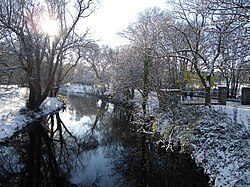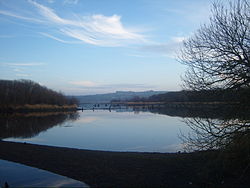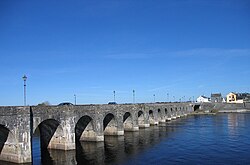Shown here are all the major rivers and tributaries of Ireland with their lengths (in kilometres and miles). Starting with the Northern Ireland rivers, and going in a clockwise direction, the rivers (and tributaries) are listed in regard to their entry into the different seas: the Irish Sea, the Celtic Sea and the Atlantic Ocean. Also shown are two tables. Table 1 shows the longest rivers in Ireland with their lengths (in kilometres and miles), the counties they flow through, and their catchment areas (in square kilometres). Table 2 shows the largest rivers in Ireland (by mean flow) in cubic metres per second.
Contents
- Longest Irish Rivers (with Basin areas)
- Largest Irish Rivers (by flow)
- Rivers in Ulster
- Rivers in the Republic of Ireland, flowing into the Irish Sea
- Rivers in the Republic of Ireland, flowing into the Celtic Sea
- Rivers in the Republic of Ireland, flowing into the Atlantic Ocean
- See also
- References
- External links

The longest river in Ireland is the River Shannon, at 360.5 kilometres (224.0 mi). The river develops into three lakes along its course, Lough Allen, Lough Ree and Lough Derg. Of these, Lough Derg is the largest. The Shannon enters the Atlantic Ocean at the Shannon Estuary. Other major rivers include the River Liffey, River Lee, River Swilly, River Foyle, River Lagan, River Erne, River Blackwater, River Nore, River Suir, River Barrow (The Three Sisters), River Bann, River Slaney, River Boyne, River Moy and River Corrib.




